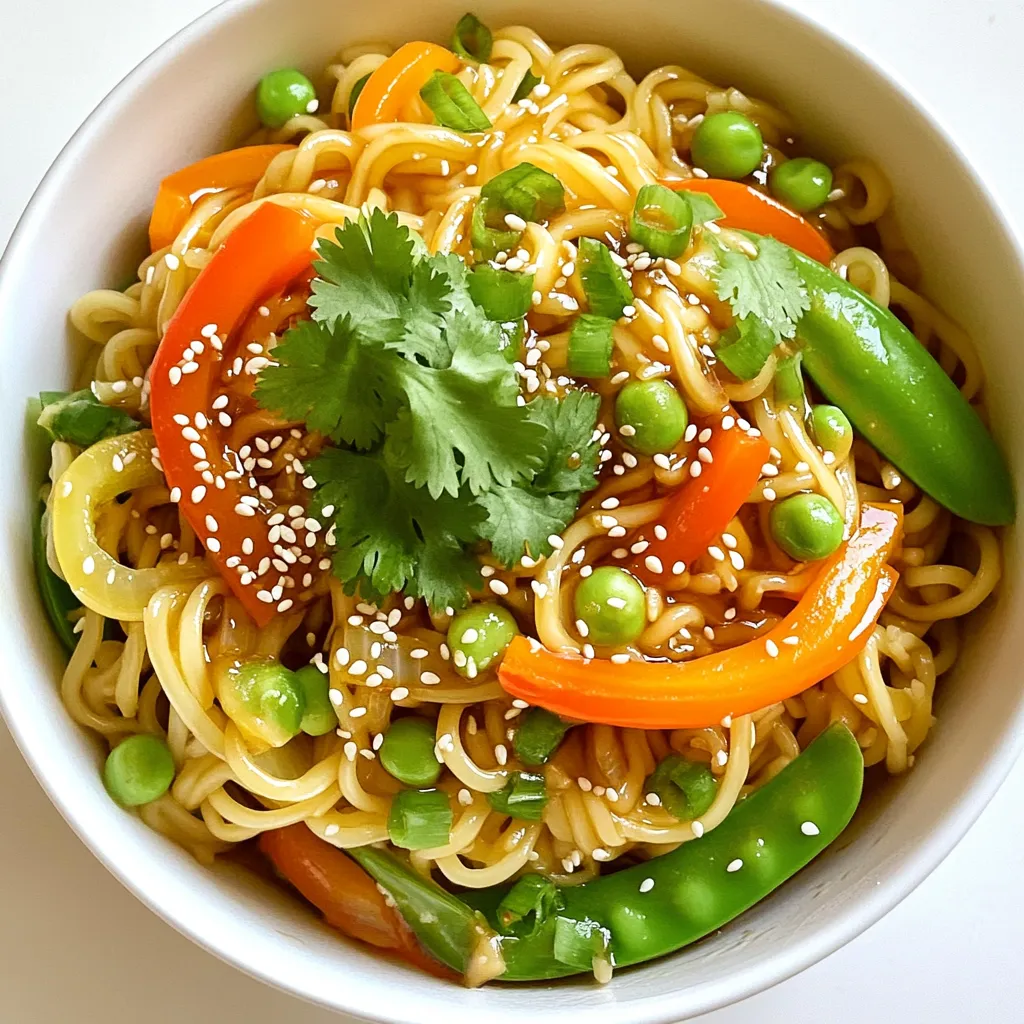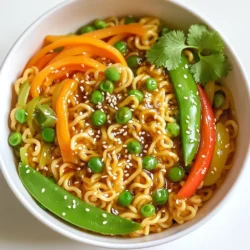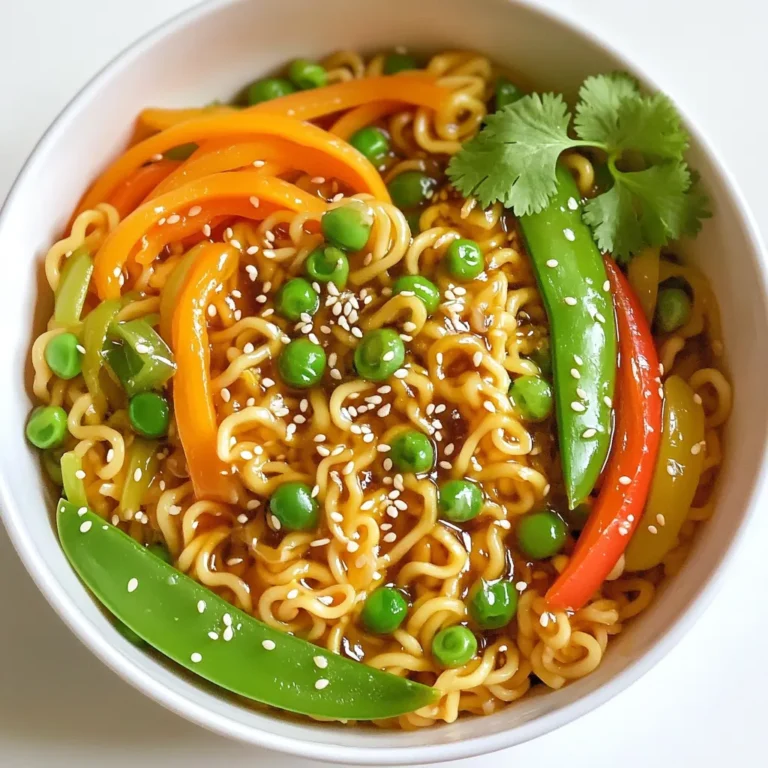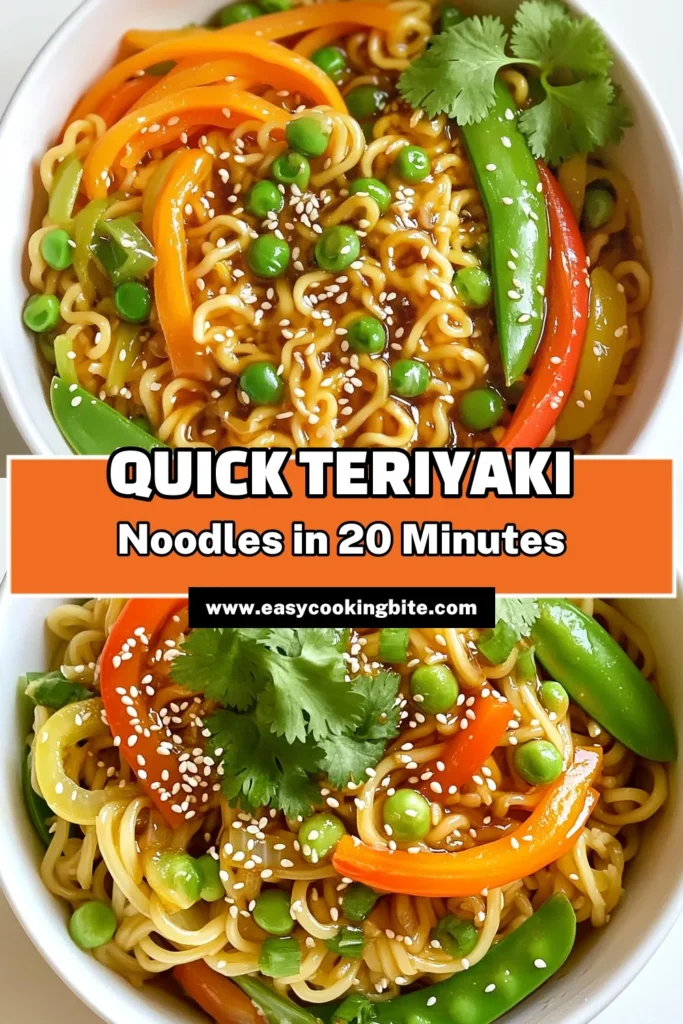Are you tired of takeout that never quite hits the spot? Let’s change that! In this guide, I’ll show you how to make Teriyaki Noodles that beat any restaurant version. With fresh ingredients, easy steps, and a few practical tips, you’ll create a flavorful dish that’s quick and satisfying. Grab your ingredients, and let’s elevate your homemade cooking to a new level of delight!
Ingredients
Key Ingredients for Teriyaki Noodles
To make teriyaki noodles, gather these key ingredients:
– 8 oz. rice noodles
– 2 tablespoons vegetable oil
– 1 bell pepper, thinly sliced
– 1 medium carrot, julienned
– 1 cup snap peas or snow peas
– 3 green onions, chopped
– 4 cloves garlic, minced
– 1 tablespoon ginger, grated
– ½ cup soy sauce (low sodium)
– 2 tablespoons honey or maple syrup
– 2 tablespoons rice vinegar
– 1 teaspoon sesame oil
– 1 teaspoon cornstarch mixed with 1 tablespoon water
– Sesame seeds for garnish
– Fresh cilantro or basil for garnish
These ingredients create a balanced dish. The rice noodles serve as a base. The vegetables add color and crunch. The sauce brings everything together.
Substitutions and Alternatives
You can easily swap some ingredients. If you can’t find rice noodles, try soba or udon. For a gluten-free option, use gluten-free noodles. Instead of vegetable oil, you can use sesame oil for a nutty flavor.
If you like heat, add chili flakes or fresh chilies. For sweetness, replace honey with agave syrup. You can use any vegetables you have on hand. Broccoli or zucchini work well too.
Importance of Freshness in Ingredients
Fresh ingredients make a big difference in taste. Fresh vegetables add crunch and flavor. They also look vibrant on your plate. Use crisp snap peas and bright bell peppers.
Fresh garlic and ginger give a strong aroma. They make your dish smell amazing. Always choose high-quality soy sauce. Low sodium soy sauce helps balance the saltiness. Your teriyaki noodles will taste better when you use fresh and quality ingredients.
Step-by-Step Instructions
Cooking the Rice Noodles
First, grab a pot of water and bring it to a boil. Once boiling, add the rice noodles. Cook them according to the package instructions. Usually, this takes about 4 to 6 minutes. Make sure to stir the noodles to prevent them from sticking. When they are soft, drain the noodles in a colander. Rinse them briefly under cold water to stop the cooking process. Set the noodles aside for later.
Preparing the Teriyaki Sauce
Next, take a small bowl and whisk together the sauce. Add the soy sauce, honey or maple syrup, rice vinegar, and sesame oil. Mix until well combined. This sauce brings sweetness and depth to the dish. Set the sauce aside so you can use it later.
Stir-Frying the Vegetables and Combining Ingredients
Now, heat a large wok or skillet over medium-high heat. Add 2 tablespoons of vegetable oil to the pan. Once the oil is hot, toss in the sliced bell pepper, julienned carrot, and snap peas. Stir-fry these veggies for about 3 to 4 minutes. You want them to soften but still stay bright and crunchy.
After that, add minced garlic and grated ginger to the pan. Stir-fry for another minute until you smell their amazing aroma. Now it’s time to add the cooked rice noodles to the pan. Pour the prepared teriyaki sauce over everything. Gently toss the ingredients together to coat the noodles and veggies evenly.
To thicken the sauce, stir in the cornstarch mixed with water. Cook for another 2 to 3 minutes. This will help the sauce cling to the noodles. Once everything looks delicious and well-mixed, it’s time to serve. Remove the pan from heat and garnish with chopped green onions, sesame seeds, and fresh herbs like cilantro or basil. Enjoy your homemade teriyaki noodles, better than takeout!
Tips & Tricks
Achieving the Best Flavor Profile
To make your teriyaki noodles shine, focus on freshness. Use fresh bell peppers and snap peas. They add a sweet and crisp taste. A mix of soy sauce, honey, and sesame oil creates a rich, savory blend. For a zesty kick, add a little rice vinegar. This will balance the sweetness. If you want more depth, try adding a splash of chili sauce. It gives a nice heat without overpowering the dish.
Cooking Techniques for Perfectly Cooked Noodles
Cooking rice noodles right is key. First, read the package instructions carefully. Overcooking can lead to mushy noodles. Boil water, add noodles, and stir gently. They usually take about 4-6 minutes. Once cooked, drain and rinse under cold water. This stops the cooking process and keeps them firm. Always toss them with a bit of oil to prevent sticking.
Garnishing for Presentation
A beautiful dish is more appealing. After cooking, serve your noodles in deep bowls. Sprinkle sesame seeds on top for a nice crunch. Add chopped green onions for a pop of color. Fresh herbs like cilantro or basil can elevate the look. A sprig of these herbs on top can make your dish look gourmet. This simple touch shows you care about presentation, which makes the meal more enjoyable.

Variations
Adding Proteins (Chicken, Tofu, Shrimp)
You can easily add proteins to your teriyaki noodles. Chicken is a classic choice. Use boneless, skinless chicken breasts. Cut them into thin strips. Sauté them in the pan before adding vegetables. Cook until they are no longer pink.
Tofu is another great option for a meatless meal. Press the tofu to remove extra water. Cut it into cubes and pan-fry until golden. Add it to the noodles at the end.
Shrimp also works well. Use raw, peeled shrimp and cook them for just a few minutes. They cook quickly, so watch them closely. Toss them in with the noodles when you add the sauce.
Vegetable Substitutions
Feel free to mix and match your veggies. You can use broccoli, zucchini, or baby corn. Just cut them into small pieces. Keep the cooking time in mind. Some veggies take longer to cook than others.
For a spicy kick, add sliced jalapeños or red pepper flakes. You can also use leafy greens like spinach or bok choy. Add these at the end of cooking to keep them bright and fresh.
Gluten-Free Options
If you need a gluten-free meal, choose gluten-free soy sauce. There are many brands available. You can also use tamari as a great substitute.
For noodles, look for rice noodles or gluten-free pasta. Just check the labels to ensure they are gluten-free. Both options work well in this dish.
These variations let you personalize your teriyaki noodles. Enjoy experimenting with flavors and textures!
Storage Info
How to Store Leftovers
To store your teriyaki noodles, first let them cool down. Place the noodles in an airtight container. Add any leftover sauce with the noodles to keep them moist. Store them in the fridge. They will stay fresh for about 3 to 4 days.
Reheating Instructions
When you are ready to eat the leftovers, take them out of the fridge. You can reheat them in a few ways. The best method is to use a pan. Heat a little oil in the pan over medium heat. Add the noodles and a splash of water. Stir them until they are hot. You can also use the microwave. Just heat them for 1-2 minutes. Make sure to stir halfway through for even heating.
Freezing Teriyaki Noodles
If you want to freeze your teriyaki noodles, they can freeze well. Place the cooled noodles in a freezer-safe bag. Squeeze out the air before sealing it. They can last up to 2 months in the freezer. When you want to eat them, thaw them overnight in the fridge. Reheat as mentioned above. Enjoy your tasty noodles anytime!
FAQs
Can I use different types of noodles?
Yes, you can use many types of noodles! Choose egg noodles or soba noodles for a twist. Each type offers a unique taste and texture. Rice noodles give a soft feel, while egg noodles add a hearty bite. Soba noodles bring a nutty flavor that pairs well with teriyaki sauce. Experiment and find your favorite!
What can I substitute for soy sauce?
If you need a soy sauce substitute, try tamari or coconut aminos. Tamari works well for gluten-free diets. Coconut aminos offers a sweeter taste and lower sodium. You can also make a quick mix with water, miso paste, and a bit of vinegar. Adjust to taste for the best flavor!
How do I make the teriyaki sauce spicier?
To spice up your teriyaki sauce, add sriracha, chili flakes, or fresh chopped chili peppers. Start with a small amount and taste as you go. This helps you find the right heat level without overpowering the dish. You can also add a dash of sesame oil for extra warmth!
In this article, we explored the key ingredients for teriyaki noodles and their importance. We covered step-by-step instructions for cooking, preparing sauce, and stir-frying. Tips for flavor and presentation enhanced your dish. Variations included proteins, vegetable swaps, and gluten-free options. Lastly, we discussed how to store and reheat leftovers.
Remember, fresh ingredients make a big difference. Enjoy experimenting with flavors and textures in your teriyaki noodles!



